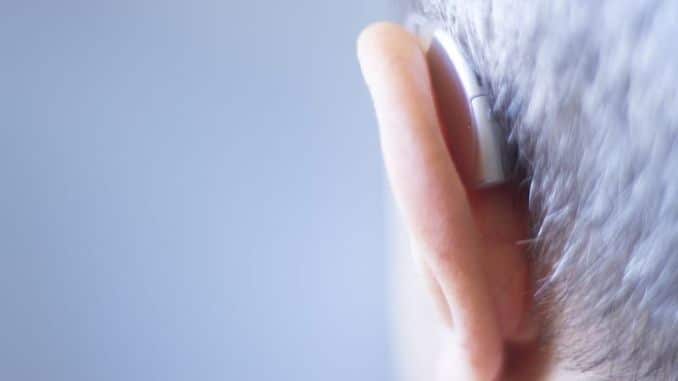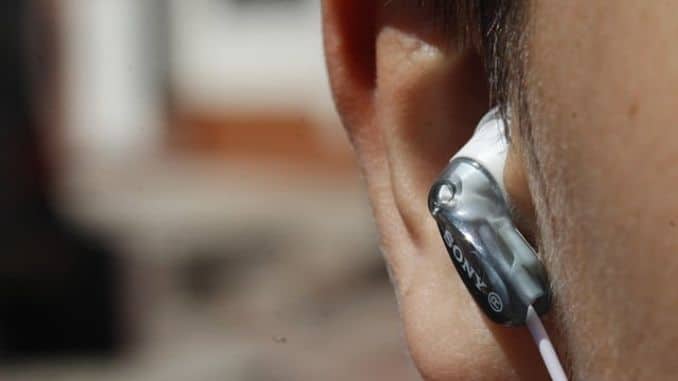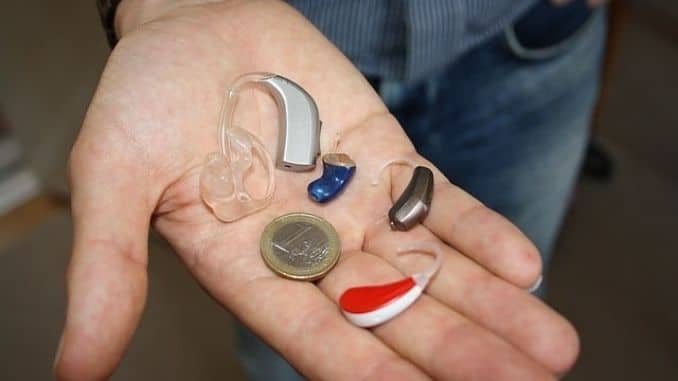
Between 2000 and 2015, the number of Americans struggling with hearing loss doubled, reaching a total of 48 million people. Globally, hearing loss is the second-most-prevalent health issue, affecting 360 million worldwide. In the United States, it’s the third-most-common health problem, behind only heart disease and arthritis.
Recent studies have found that hearing loss can be much more dangerous than we thought. According to research from Johns Hopkins, even mild hearing loss doubles the risk of dementia. Moderate loss triples risk and people with a severe hearing impairment are five times more likely to develop the disease.
Hearing loss is also tied with a greater risk of falling, a higher risk of accidental injury and higher health costs over time.
Fortunately, we have a way to address the issue and reduce the risk of all these negative complications: hearing aids. Technology has resulted in significant improvements in these devices during the past decade. No longer are they the clunky, heavy things you watched your grandfather use.
Of course, with these technology advancements comes confusion, so which hearing aid is right for you?
Why Is Hearing Loss Increasing?
The number of people affected by hearing loss is expected to continue to increase — dramatically — into the future. According to a 2017 study published in JAMA Otolaryngology-Head Neck Surgery, the number of adults 20 years or older with hearing loss will rise to 73.5 million by the year 2060 — almost doubling the current number.
The World Health Organization (WHO) estimates that by the year 2030, nearly 630 million people will have disabling hearing loss and, by 2050, as many as 900 million could be affected. The numbers have been increasing steadily over the past decade, with countries like China, the U.S., India, Japan, Mexico, the Philippines and more all experiencing significant increases.
As to why this is happening, there are several factors involved, including the following.
Population Increase
During the next several decades, the overall global population is expected to continue to grow. There will be more people on the planet, which translates to more affected by hearing loss.
Aging Population
As the population grows, the senior proportion of that population will grow too. Although anyone at any age can develop hearing loss, older people are more at risk because of long-term wear and tear that causes changes in the inner ear and sometimes along the nerve pathways leading to the brain.
Heavier Use of Earbuds
Although earbuds allow us to listen to music, podcasts, audiobooks and more without bothering those around us, they are often set too loud, to the point that they cause hearing damage over time. As more people use earbuds with their music players, smartphones and other devices, more people are vulnerable to hearing loss.
According to a recent study, between 1988 and 2006, there was a 31 percent increase in hearing loss among those between 12 and 19 years old. That means that one in five teens now suffers some sort of hearing impairment. Researchers believed the culprit to be a combination of earbuds and loud music.
Noisier World
Our world today is much noisier than it used to be. Environmental noise, in fact, has become so pervasive that the WHO labeled it an “underestimated threat,” linking it to short- and long-term health problems including sleep disturbance, cardiovascular effects, poorer work, and school performance and hearing impairment.
In a 2014 study on noise exposure in the U.S., researchers found that an estimated 104 million individuals had annual levels of exposure at more than 70 A-weighted decibels (dBA), putting them at risk of noise-induced hearing loss. The WHO says that noise should not exceed 50 decibels during the day and should be less than 35 at night in residential areas.
Environmental noise comes from planes, trains, subways, vehicles, televisions, radios, household appliances and more. Although most sounds at safe levels don’t damage hearing, sounds can be harmful when they’re loud, even for a brief time.
Other Causes
There are many different causes of hearing loss too. These include damage to the inner ear ― which can develop after exposure to loud sounds, such as that which may occur when spending time in the military ― ear infections, abnormal growths or tumors in the ear, an injury to the ear or a general buildup of earwax.
What Are the Symptoms of Hearing Loss?
Often, it can be challenging to know if you’re experiencing hearing loss. You don’t have anyone’s ears but your own, so you can’t compare. Besides, hearing loss usually develops gradually, meaning that it’s easy to adapt as we go.
It’s usually someone else in your life who points out your hearing problems to you. While it may feel uncomfortable to learn that your hearing is not as acute as it once was, it’s much better to be aware so that you can do something about it than to continue without knowing.
If you’re unsure how your ears are doing, watch for these types of symptoms:
- High-pitched sounds are more difficult to hear, which means that you may have a harder time understanding the voices of females and young children
- Difficulty following conversations in restaurants and other places where there is background noise
- Others seem to mumble when they talk
- You often ask others to repeat what they said or to speak up
- You are continually turning up the radio and television.
- Talking on the phone has become more difficult
- Certain consonant sounds are easy to miss, including s, sh, f, v, th, f and p sounds
- You’ve left your blinker on numerous times because you didn’t hear it clicking
- You no longer notice birdsong
5 Questions to Help You Choose a Hearing Aid
If you relate to any of the symptoms above, you may have hearing loss. Although mild forms may not be too bothersome, once the condition starts interfering with your daily activities, it’s time to get help. Hearing loss is a serious problem and, without treatment, can increase the risk of dementia, isolation, falls, accidental injuries and depression.
Your best bet is to consult with a trained professional, such as an otolaryngologist ― ear, nose, and throat specialist ― who will evaluate your hearing and determine your level of hearing loss. He or she can also help you decide whether a hearing aid may be useful and what kind might be best.
Meanwhile, here are five questions to ask yourself when choosing a hearing aid.
1. Should You Go for Prescription Hearing Aids or the Newer Over-the-Counter Types?
In 2017, the U.S. Food and Drug Administration (FDA) passed the Over-the-Counter Hearing Aid Act, which opened the market to over-the-counter hearing devices. Before that, the only way you could get a hearing aid was to have one prescribed by a licensed hearing professional.
The idea is to make these devices more generally available to the public. Soon, real hearing aids will be available without any type of prescription or involvement from a doctor. The change will provide a helpful and often lower-cost option for those with mild-to-moderate hearing loss. The FDA must approve each product for hearing loss, however.
The FDA plans to have regulations for this class of products in place by 2020. Meanwhile, don’t be fooled by other hearing assistance products that are currently available. These are called Personal Sound Amplification Products (PSAPs). Unlike hearing aids, they only amplify sounds to make them louder. The FDA prohibits manufacturers from marketing these to people with hearing loss.
PSAPs are not tailored to a person’s hearing loss, but they can help some people with mild to moderate hearing impairment.
The effectiveness varies depending on the product, so it’s best to do your research before trying one. In general, it seems the very inexpensive ones (less than $50) aren’t helpful, but those between $350 and $500 or so may help diminish background noise and improve the ability to hear things like conversations and television shows.
2. What Do You Need the Hearing Aid to Do?
Because hearing aids vary in technology and style, it helps if you’re clear on where you need the help. Do you notice hearing problems mostly when watching television, when trying to stay involved in conversations or when trying to hear a sermon in church? The more specific you can be, the better your chances of getting a device that works well for you.
3. What Style Do You Like?
Hearing aids come in four basic styles. Each has its pros and cons:
- In the ear: These are worn within the ear and are custom-fit. These are best for those who want their device to be discreet. They also provide excellent sound quality because of how they fit inside the ear, which can reduce distracting sounds. Some even come in different skin tones so that they blend better with your outer ear. They can be more susceptible to earwax and moisture damage, however, and can be difficult to manipulate because of their small size.
- Behind the ear: These have a speaker that rests on the ear canal while the microphone and processor sit in a tiny case behind the ear. They are available in different colors to match hair and skin tone. Many have a rechargeable battery option, but they are more visible than other options.
- In the canal: These are slightly larger than the other styles, and they sit in the lower portion of the outer ear bowl. They’re comfortable and easy to use and tend to have a slightly longer battery life. Their larger size also enables them to have additional features like a volume wheel if desired. They are also susceptible to earwax and moisture damage, however, and may make users feel like they’re “plugged up.”
There are other types within these major categories too. It’s best to review the advantages and disadvantages of each before choosing.
4. Do You Need Technology Connectivity?
Many hearing aids today offer advanced technology functions. You can get apps for your smartphone that help you personalize your listening experience, for example, or get a hearing aid made specifically for connecting to your streaming devices. If you want to stream music or movie audio through your hearing aid, for example, you can do that with some hearing aids available today.
5. What Is Your Budget?
Hearing aids range in price from $1,000 to $4,000 each, depending on the technology used. Because most people need one for each ear, the costs can be significant. Unfortunately, hearing aids aren’t usually covered by insurance. Ask your doctor about financing options and, if you’re a veteran, check with the U.S. Department of Veterans Affairs or your state’s vocational rehabilitation program.
Can You Prevent Hearing Loss?
The best way to prevent hearing loss is to protect your ears from loud noises. The “safe range” is anywhere from 0 decibels to 75 dB, which is equivalent to the sound a vacuum cleaner or average radio makes. Between 80 and 85 is risky, and anything above 85 is considered harmful to the ears.
Examples of noises that typically expose you to higher than safe levels include the following. When you’re exposed to these, be sure to use hearing protection:
- Heavy traffic
- Power lawn mower
- Subway
- Boom box
- ATVs and motorcycle engines
- Chainsaws, leaf blowers
- Gunshots
- Sports and concert events (with loud crowds or music)
- Auto races
Eating right is a huge part of staying healthy. For your guide to the best foods to heal and slim your body, check out The Best Foods that Rapidly Slim & Heal in 7 Days, here!






